Gossamer Gear’s The One and the Durston X-Mid 1 Solid: First Impressions
I’m not recommending trekking pole tents for winter or deep snow events. This review concerns ultra-light tent options for long-distance backpacking in the summer and fall and in moderate weather conditions.
In the last few years our winter hiking community has been doing more non-winter events—overnight coastal trips and section hiking the PCT, as well as other summer and fall trips not involving snow. We are in the process of learning more about ultra-light summer gear.
For these milder-weather events, trekking pole tents offer a significant weight reduction by eliminating tent poles and using trekking poles instead. Late summer and early fall are times when ultra-light backpacking methods work well. For this reason, I started looking into trekking pole tents that I could recommend to other hikers in our group. After researching available options, I reached out to Durston and Gossamer Gear to see if they would allow me to try out their tents.
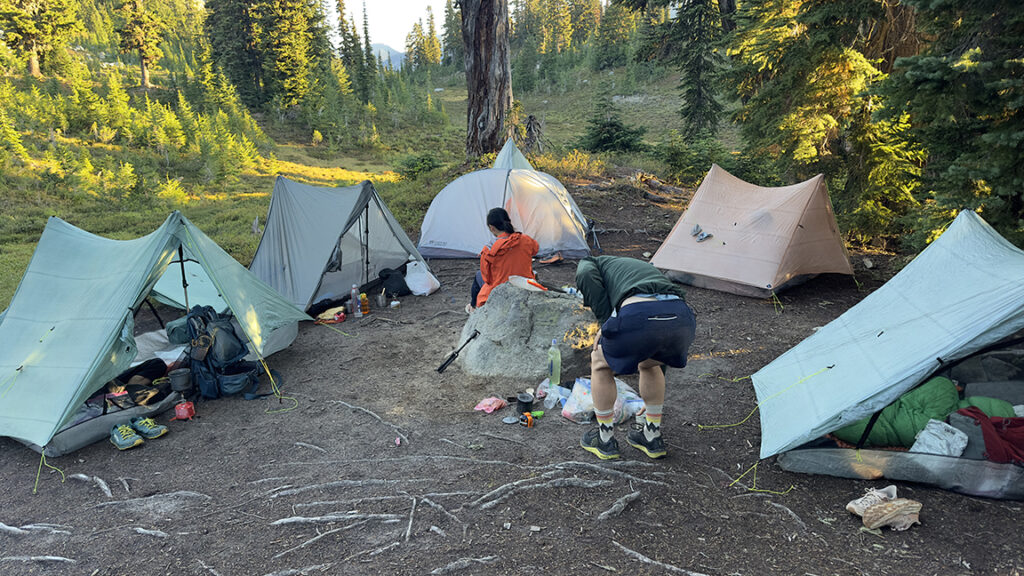
I was attracted to their tents for two main reasons, both offered a significant weight reduction compared to free-standing 3-season tents and both were affordable compared to Dyneema alternatives. Cost is important because many hikers in our community have already invested in 4-season tents and other winter gear. If you’re buying a second tent that you will only use for a few trips out of the year, you don’t want to burn through a lot of cash.
I asked Durston to send me their X-Mid 1 and Durston suggested that the X-Mid 1 Solid, a version of the X-Mid that “is oriented towards use in colder conditions including winter use and trekking in windswept areas.” This seemed reasonable, so I accepted that offer. I asked Gossamer Gear to send their tent called “The One.” Both are solo tents.
Basic specs compared
Gossamer Gear’s The One
- Dimensions: 84” L x 33”/21” W (head/foot) x 45” H
- Packed size: 5”x10”
- Tent body & floor: Custom 10D Nylon Ripstop SIL/PU fabric waterproof to at least 1800mm0
- Weight: 1 lb. 4 oz (shelter weight, includes guylines, 6 aluminum stakes)
- Costs: $255 (September, 2024)
Durston X-Mid Solid
- Dimensions: 90” L x 32” W (head/foot) x 46” H
- Packed size: 5”x12”
- Tent canopy and floor: 20D Sil/PE Polyester 3500mm HH in Alpine Sage
- Weight (Tent, Sack, 6 Stakes): 1 lb. 15.9 oz / 905 g
- Costs: $265 (September, 2024)
Gossamer Gear, The One
The Gossamer One arrived first. I set it up behind my house where the ground is flat and the soil consistent. The setup was quick and easy. I was eager to try it out on my next trip near the end of July, a 24-mile hike camping at around 6000 ft in the Cascade Mountains. I knew the snow would be reasonably firm so I took The One. It takes a little more time to set up on snow than the first stage of a 4-season tent. For that reason, I would not want to use The One in cold windy weather. The weather was warm (50s F) and not very windy. The trekking poles became stable after sinking about 8 inches into the snow. This meant I could not use the grommets on the tent that hold the tips of the poles but this was not a problem.
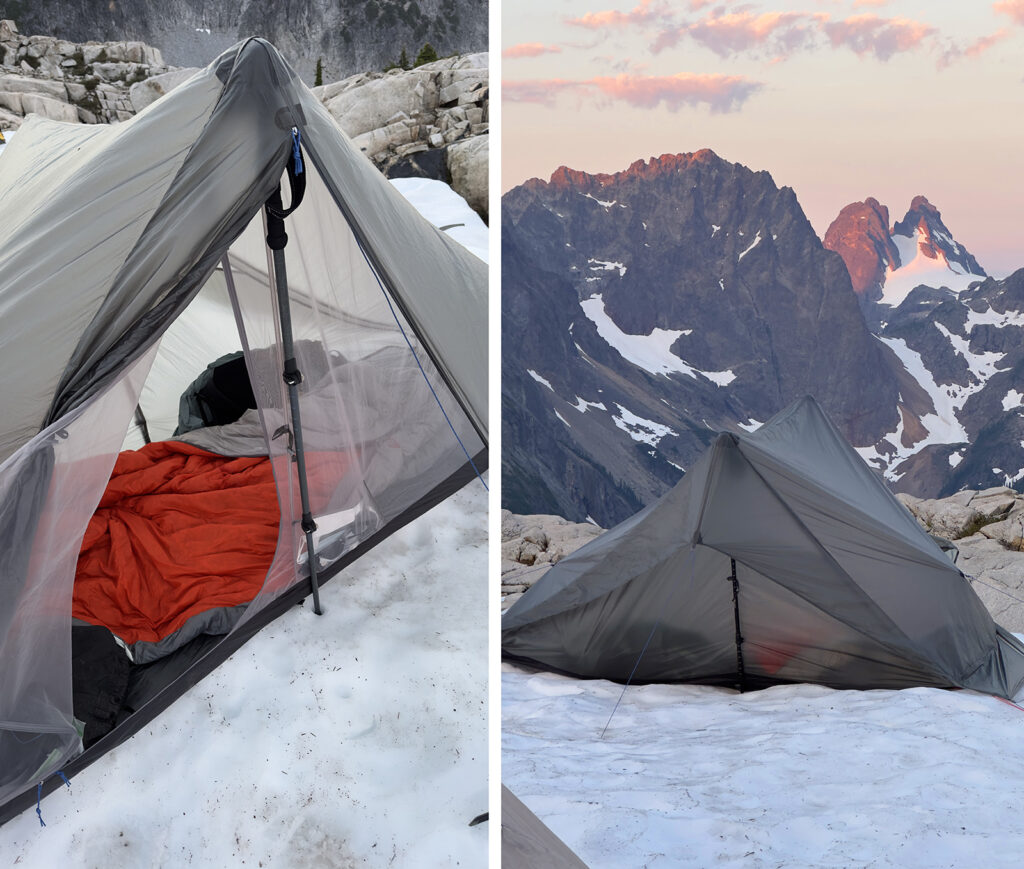
The tent is roomy enough that I could store my pack and gear inside much in the same way I would use a 4-season tent. It breaths well and condensation was only a minor issue. The tent vestibule is large enough for cooking and it has a convenient pocket by the door for my eyeglasses and headlamp.
Most 3-season solo tents are 2.5–3.5 lbs, so a tent weighing only slightly more than a pound is a significant and welcomed reduction in weight. I think this is an excellent option for long-distance, ultra-light, warm-weather hiking.
You can reduce weight further by switching out some or all of the aluminum pegs for lighter titanium alloy wire pegs.
Durston X-Mid Solid
I had two trips planned in August. On the second trip I didn’t expect any snow so I took the Durston X-Mid Solid. I also brought the
Gossamer One. The reason I brought both tents is because one hiker had a 4.5 lb tent and I encouraged her to leave that at home and use one of these lighter tents instead.
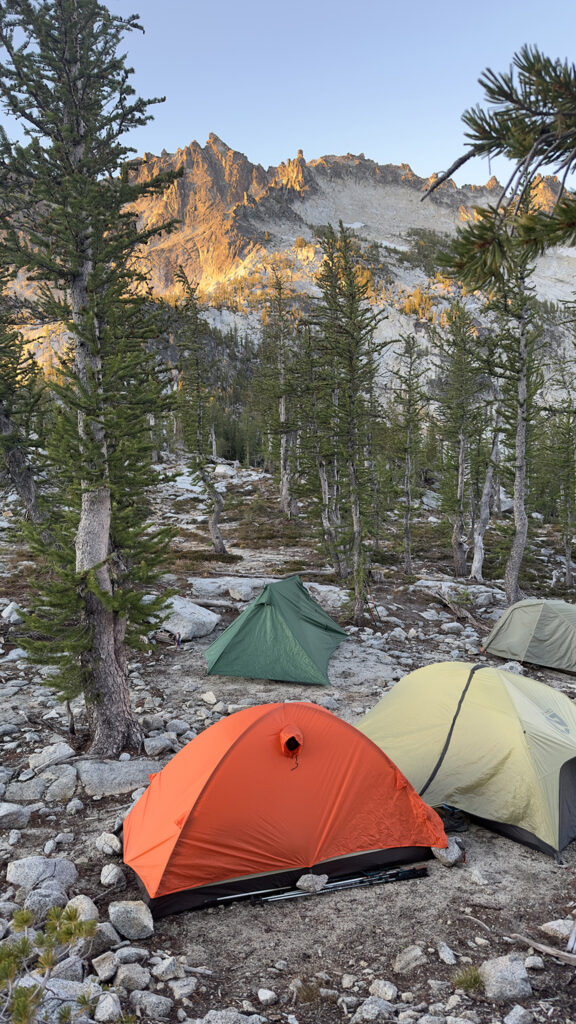
This trip was on August 27, 2024, and we found ourselves caught in an unexpected snowstorm while going up a steep 2000-foot slope in the Alpine Lakes Wilderness.
By the time we were out of the gale-force wind some of the hikers had lost too much core warmth. I encouraged everyone who could share tents to do so and to get out of the wind as quickly as possible, to change into their dry base layers, and make hot water bottles. Within minutes of reaching our camp, all the hikers had their free-standing tents set up and were out of the cold wind. Because of their tent-sharing arrangement, no one needed my extra tent and I decided to use the sturdier Durston X-Mid Solid. I assumed it would be the best option for these harsh conditions.
I had set up the X-Mid Solid behind my house when it arrived. I watched their online tutorial on YouTube and found the setup reasonably easy so I didn’t expect any difficulties on this trip.
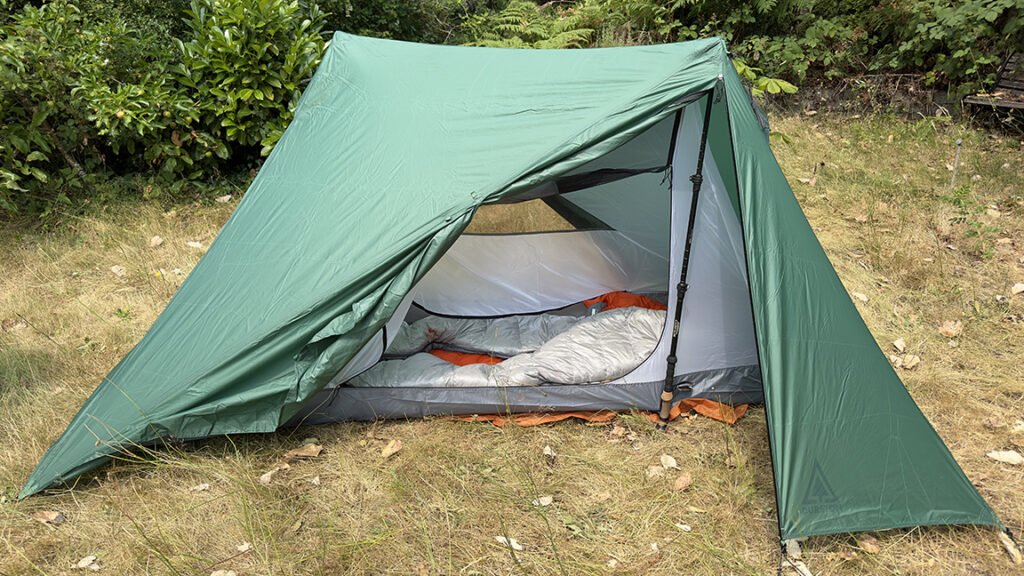
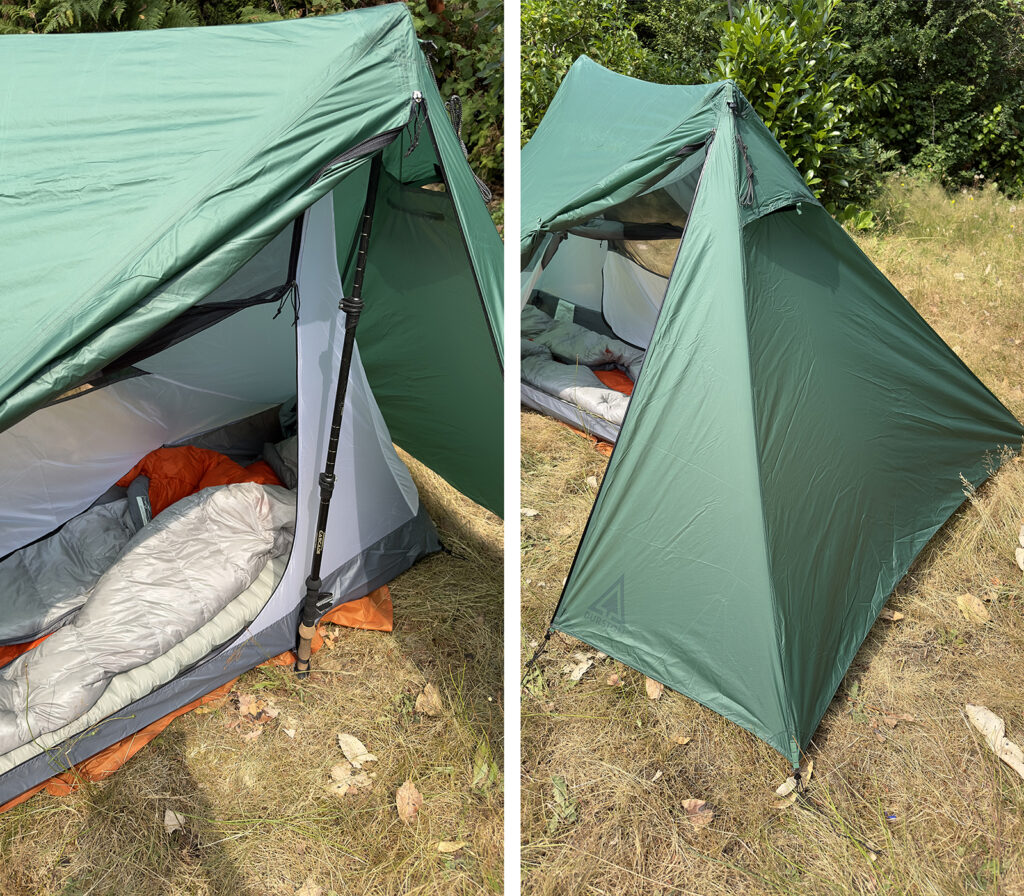
Unfortunately, I was pitching the tent in high winds and in the dark. I under-estimated the difficulty. The first problem was finding enough open space to set up this tent. Even though it is a solo tent it actually takes up a lot of space compared to most freestanding solo tents. The ground surface was a worse problem. As is typical in the Cascade Mountains, the ground was a combination of dirt and rock. Finding dirt that would accept tent pegs was challenging and forced me to position the pegs where the alignment didn’t create the sufficient tension for the trekking poles. For one corner the ground was solid rock and I had find a large stone to attach to the guylines and then more stones to make it secure. I also needed to girth-hitch the guylines to the loops on the pegs to secure the lines in the gusting wind. It took about half an hour to get the tent to stand up without the poles falling over. The poles still fell over during the night several times even though the pegs held. I got through the night but the extra time in the cold wind drained my core warmth.
If I had more experience setting up this tent I might have had a better experience. This is not the kind of weather I expect at the end of August but this is the Cascade Mountains so you must be prepared.
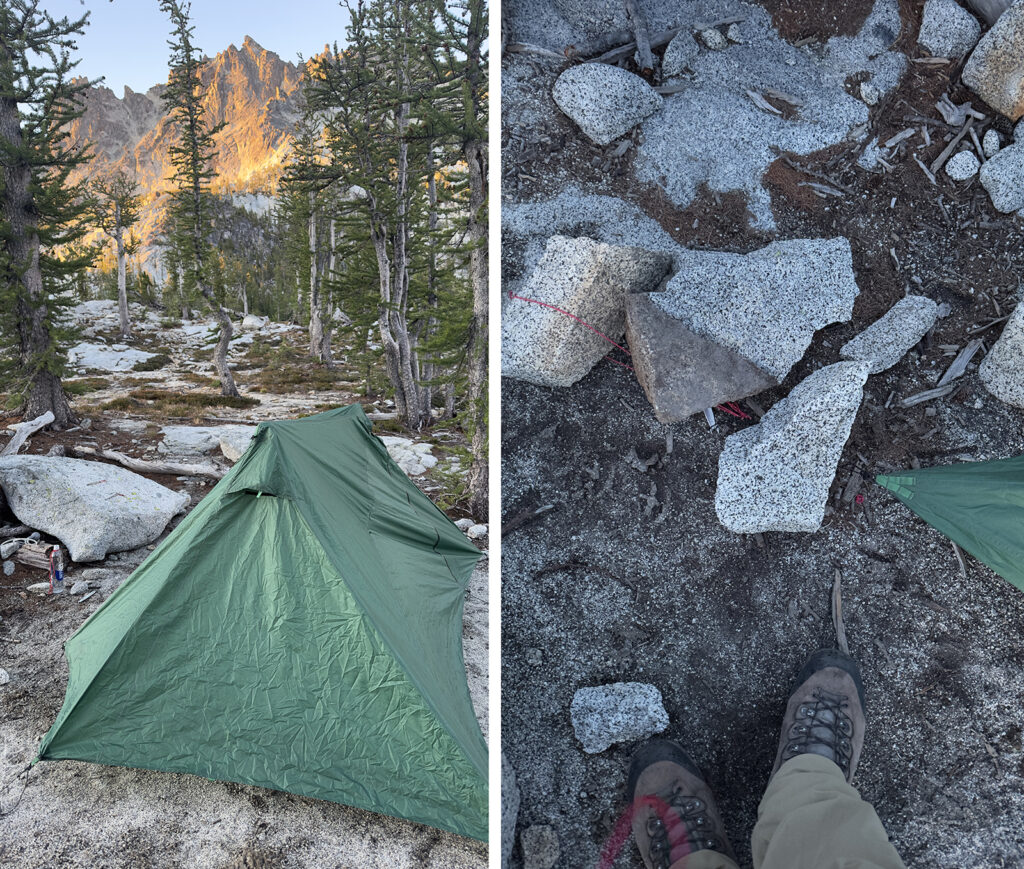
The Durston X-Mid Solid is a well-made tent. Out of the box, the first thing you notice is the quality—solid construction and the durable materials.
This particular model has a 4-season style inside material that will stop snow drift and add more warmth than regular mosquito netting. Unlike the single wall Gossamer, the X-Mid has a full double-wall design using non-sag poly fabric. It has thicker coatings, large adjustable vents, waterproofed seams, and a full down-to-the-ground coverage fly. The zippers are tough and there are doors that open on both sides (a luxury not typical for a solo tent).
The design is well-thought out and interesting. Durston has solved a common trekking pole tent problem—the entrance on most trekking pole tents is blocked by the trekking pole. I noticed this the first time I used the Gossamer One. The X-Mid design allows you an entrance unobstructed by the poles because the poles are positioned in the corners.
The X-Mid is a substantial tent, but this comes at a weight cost of nearly two pounds compared to the roughly one pound of the Gossamer One. But at 2 lbs, it is still light and still competitive with many ultra-light tent alternatives.
All that said, trekking pole tents, and this particular X-Mid model, are going to be easier to set up on large flat areas with minimal rocks. Most established campsites tend to have dirt surfaces large enough, but when you have group sizes of 6–12 hikers bringing their own solo tents you need tents small enough to fit into these tight campsites. Because of the large vestibules on both sides, this tent takes up a significant amount of space. If you are hiking with just one or two other hikers, using established campsites, or setting up on less rocky terrain, then setting up the X-Mid will be less challenging. Once you get away from established campsites, tents like these are going to be more chasllenging to use, especially in rocky places like the Cascade Mountains or Sierra Nevada.
Weight and ease of use are deciding factors
My next planned trip was a seven-day hike along the K-section of the PCT. For this, I decided to take the Gossamer One. It is lighter, easier to set up, and takes up slightly less space. As it turned out, forest fires closed the K-section and any possible modified route in and out of the Glacier Wilderness. We decided to repeat the PCT J-section and to do it in 4 days (we did in 5 days in 2023).
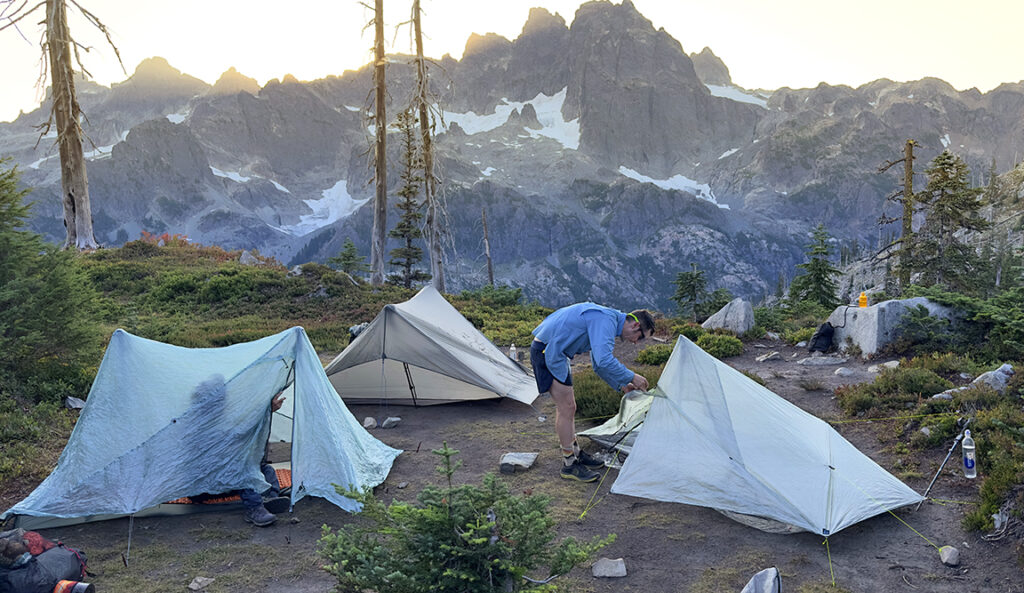
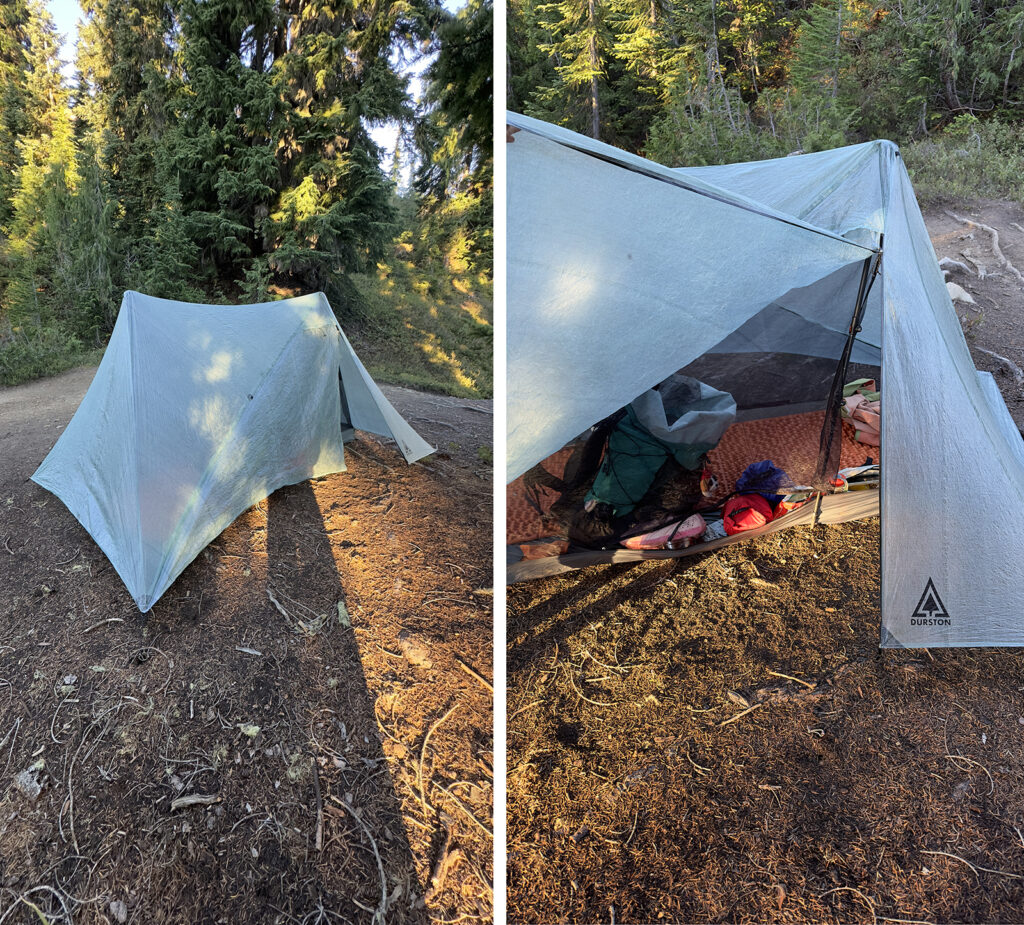
The Gossamer was easy to set up in every location on the J-Section. To be fair, the Durston X-Mid would have easily worked in these campsites too and, in fact, one of the other hikers brought the Dyneema version, the X-Mid Pro 1.
I chose the Gossamer Gear The One because it had the weight advantage over the X-Mid Solid and the weather was warm and mild. So I had no need for a warmer tent.
The Rain Test
The next test for the Gossamer One would come in September on a trip to the Canadian Rockies.
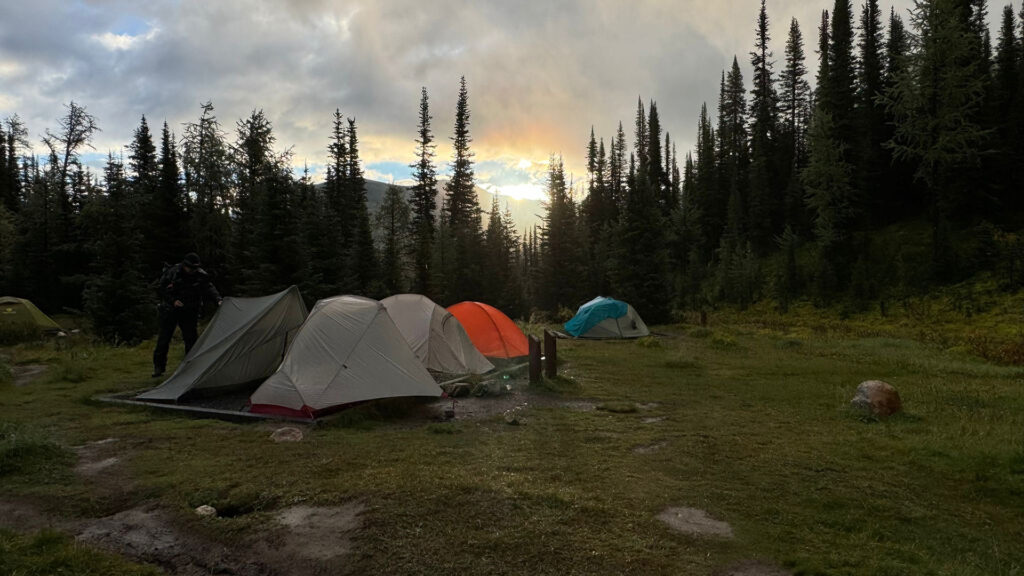
The forecast was cold and nearly solid rain for five days. Would the Gossamer One keep me dry? I wasn’t sure. As a safety precaution, I switched out my down sleeping bag and jacket for synthetic options. I also brought a sponge and extra hand towels. Each night condensation would run down the inside of the tent and small puddles of water would form in the corners. This water was too insignificant to pose a threat to my gear and could easily be sponged up in the morning. Some hikers may think the seams are leaking but this is not what’s happening. The roof of this tent is a single wall and the moisture is simply condensation.
This can be expected in any single-wall tent. When heavy drops of rain would land on the roof of the tent, the impact would cause tiny droplets of condensation to sprinkle on my face and sleeping bag. I have a similar experience in winter when wind shakes the tent and tiny specs of frost shake loose from the tent walls.
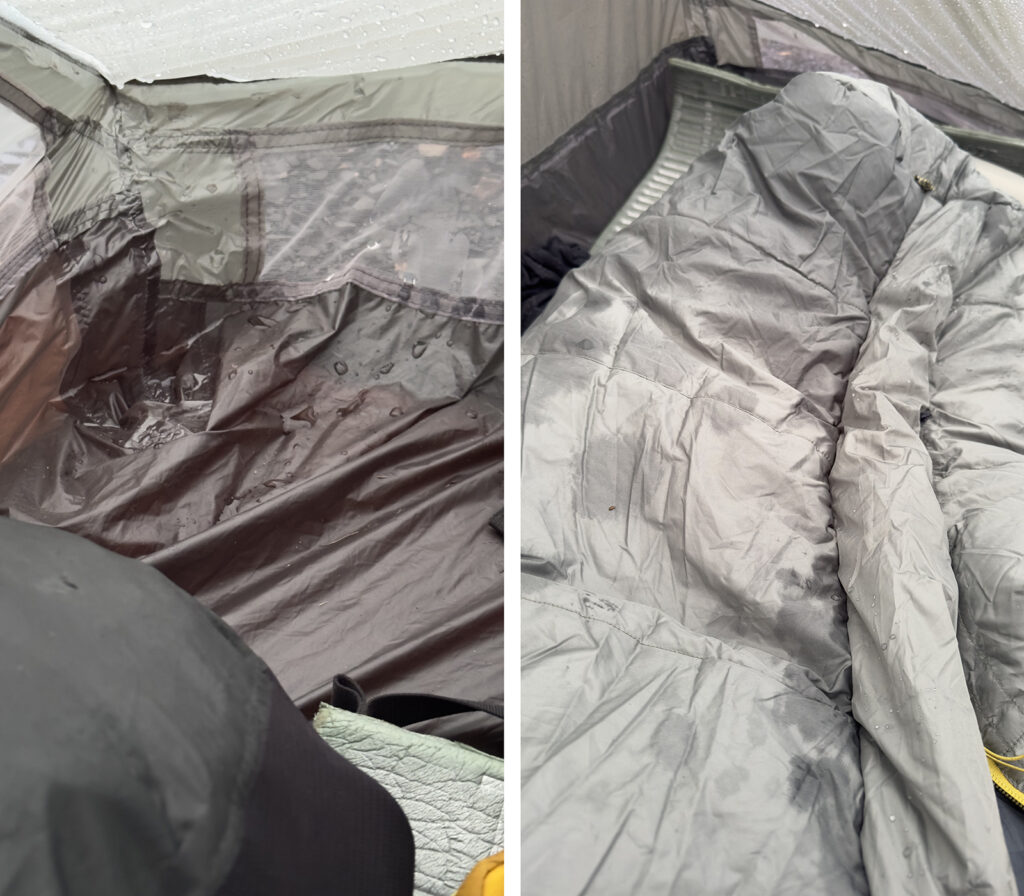
Because of this condensation, I would probably stick with a synthetic sleeping bag on cold rainy multi-night trips. It is hard to keep the end of the sleeping bag away from the sloping wall of the tent. The foot of the sleeping bag will most likely get wet, as mine did, and that will be a more serious problem if the bag is down filling. Each day, the synthetic sleeping bag dried out quickly and it never lost loft from the minor surface wetness. On warmer, drier and shorter trips I will stick with a down sleeping bag.
All in all, I found the Gossamer One to be a good option for thru-hiking or any multi-night summer backpacking trips, including treks in persistent rain.
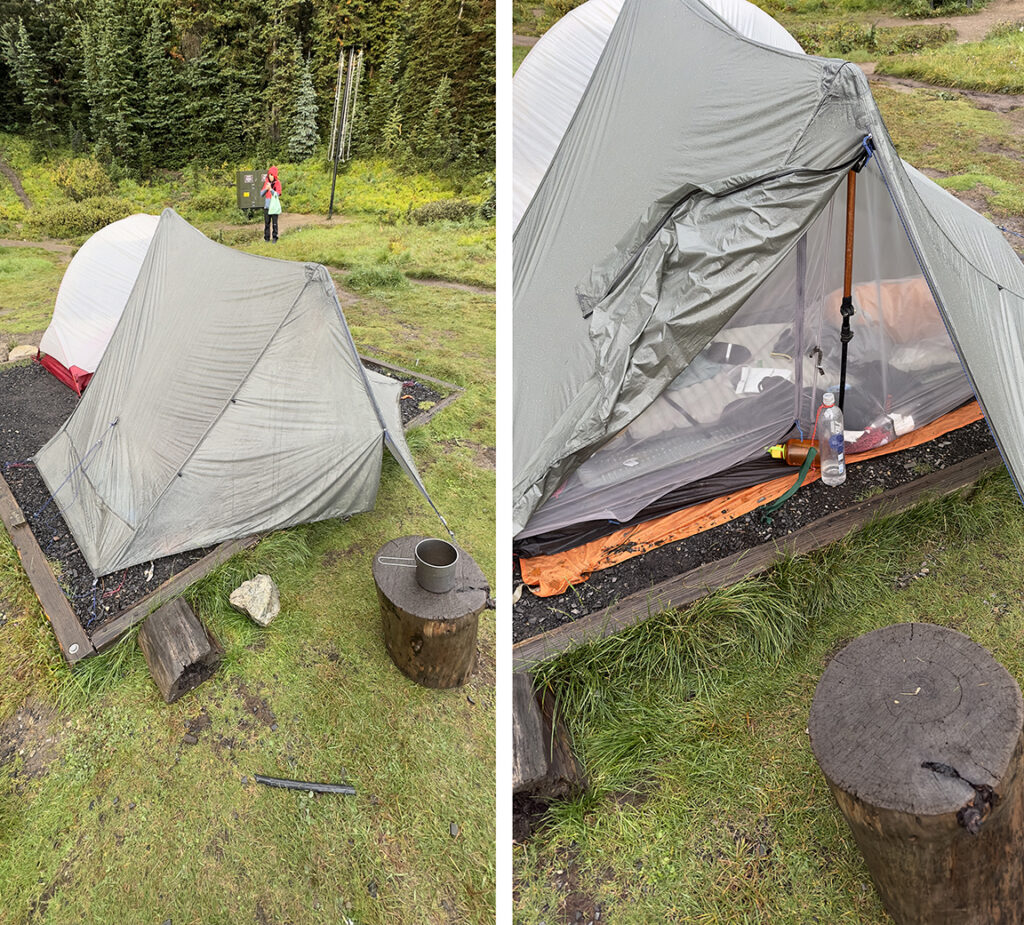
If I was hiking in less rocky, flatter terrain, and harsher weather, the X-Mid Solid might be my preferred option. I plan to improve my skills setting up the X-Mid because there may be some situations where this tent would work better than the Gossamer. I think everyone has to look at these tent choices based on the terrain where they will be using the tent and the weather. In the Pacific Northwest, there is a lot of rain, but it tends to be light and often misty. We rarely get the kind of intense downpours that occur east of the Rocky Mountains.
The X-Mid needs to be set up with a level precision that is not required by the Gossamer Gear One. However, in heavy rain, the Gossenar has to be pitched carefully so that the mesh air vents on the ends are not laying on the ground and allowing water to stream in.
The Wind Test
Canada provided the rain, but next I decided to push my luck and take the Gossamer up in the Cascade Mountains at the end of September.
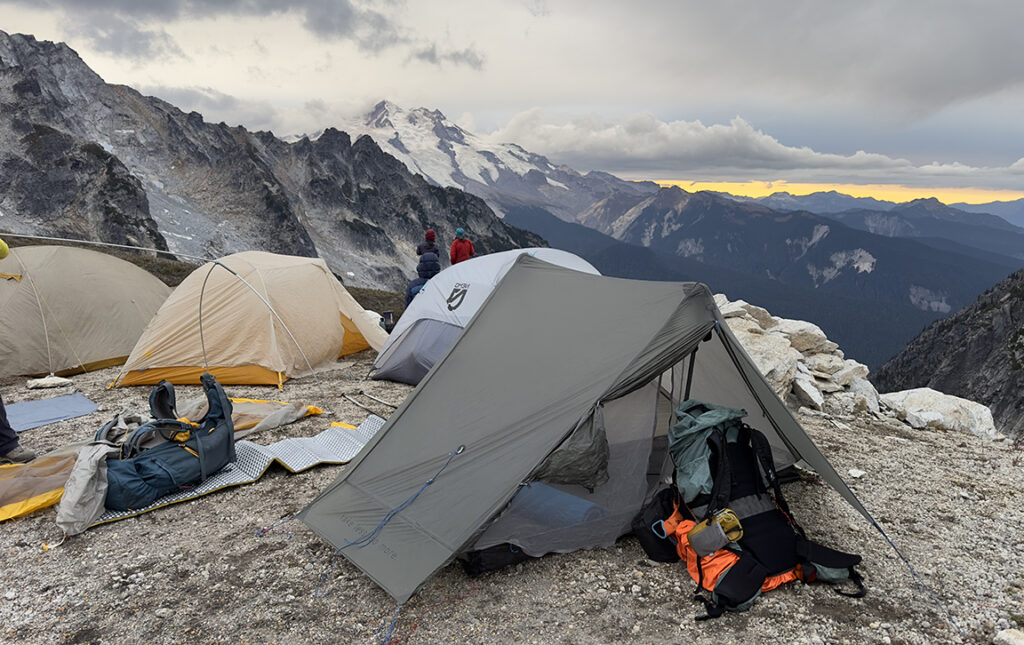
The forecast indicated possible winds around 20 mph/32 km and temperatures in the 20s F. When we set up it was mild enough for everyone to let down their guard. To save weight, I switched out some of the aluminum pegs for titanium wire pegs. That was a mistake.
When the gusts came it was sudden and the tent pegs were pulled out of the ground instantly. Many of us were scrambling to secure the north-facing lines with rocks. None of the free-standing tents collapsed nor the X-Mid Pro 1, but the Gossamer was flat. I was able to secure the lines with large rocks and set up the tent again. It would blow over one more time when the wind changed directions and pulled out another peg. The main problem was not having pegs that could secure the tent. None of the tents were torn. Even the flimsiest ultra-light tents held together. But I wouldn’t want to use any of these ultra-light tents in higher winds, especially gale-force winds.
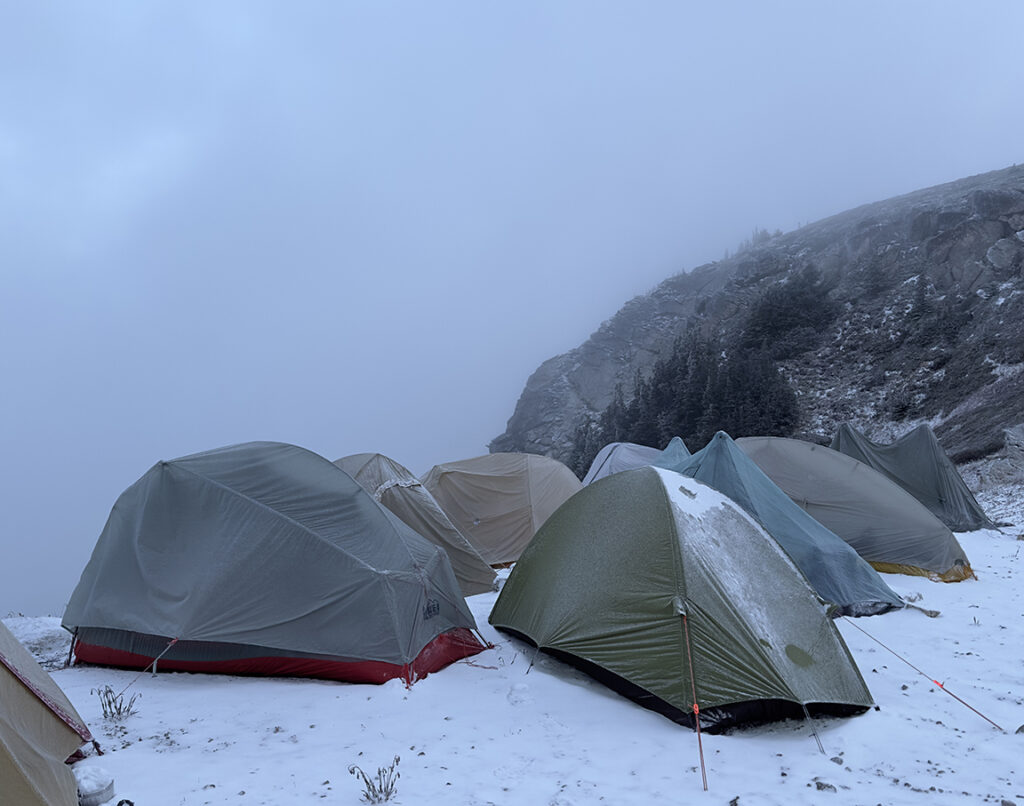
With September ending, winter conditions will be arriving in the mountains and it is time to bring out the 4-season gear. But I look forward to using these tents again when milder weather returns.
Conclusion
Both of these tents are good ulta-light backpacking tents. The Gossamer One is exceptionally light for a tent in its price range. It is a good choice when weight and cost are the foremost priorities.
The X-Mid 1 Solid stands out for its design and quality construction. It is light and sturdy. There is probably no tent made this well in its weight range.
Overall, from a winter backpacking point of view, I don’t recommend trekking pole tents for winter conditions. Free-standing tents, both 3-season and 4-season versions provide greater stability and allow you to escape the wind much quicker, which is an important safety consideration when it is cold and you are arriving at camp in sweaty clothing. It is essential to change out of your sweaty clothing and layer up in dry camp clothes quickly to avoid hypothermia. Being able to quickly slide the tent poles in the sleeves and anchor a free-standing tent with a pack in high winds can save your life. That said, by the end of July, we are rarely camping on snow. Trekking pole tents are an excellent weight-saving option for non-winter conditions.
What do you think?
Let us know what ultra-light tents you are using and what you think about them. Share your comments below.
3 replies on “Trekking Pole Tents”
Hi Michael,
Have you had a chance to take a look at the new Durston X-Dome 1+ tent that was launched this week? It’s a 35-ounce, fully freestanding doublewall tent utilizing an X-Mid floorplan. Do you think this tent would be a good choice for me to bring on winter trips with your winter backpacking Meetup group? I’m concerned about the amount of mesh vs solid fabric on the inner tent, although Durston feels the solid fabric is high enough to reduce exposure to cold drafts when the user is lying down in the tent. I’m also concerned that the pole structure is not a traditional X-shape, although the pole structure can be strengthened by attaching trekking poles to each end of the crosspole. If you have any preliminary thoughts on this tent based on the information available on Durston’s web site, I would appreciate hearing them. Thanks!
I have not yet seen the Durston X-Dome 1+ yet but it looks sturdier than most 3-season tents. If you only want to budget for one tent to use year-round, this may be a good option. 4-season tents are not very comfortable in the summer.
There are hikers using 3-season tents on our events. The mosquito netting allows them to breathe well in the summer but in winter this lets in cold and snow drift. The lower the mosquito netting is to the floor the more snow drift and cold gets in. Typically, a 4-season tent uses an inner wall fabric that does not allow snow drift through. The Durston X-Dome 1+ appears to use mosquito netting. Its not really a double-wall tent in the sense of a 4-season tent but the fly does extend to the ground which should help mitigate the draft and snow drift problems.
Bear in mind, that in deep snow you need your trekking poles to move around camp. Without snowshoes and trekking poles, you simply sink in the snow and loose your balance. It is best to not rely on trekking poles for tent support in winter. That said, this tent will likely hold up fine.
Hi David, Let us know which tent you decided on, or better, bring it to one of our events!